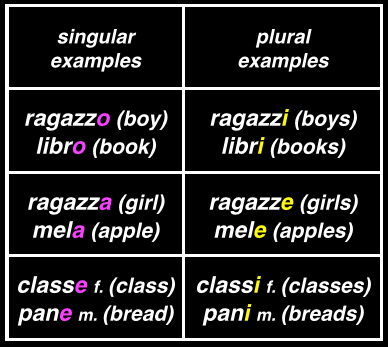Italian Nouns: Singular and Plural
- The Gender of Italian Nouns: Masculine & Feminine
- Italian Nouns: Singular and Plural
- Definite Articles
- Indefinite Articles
Introduction to Forming Plural Nouns
If you are already familiar with how gender works in Italian, you can learn how an Italian noun changes from singular to plural. Changing a noun to the plural form is based on the ending of the noun. This lesson deals with the most common noun patterns. As with most languages there are several exceptions to the rules outlined below, and these are treated in other areas of 99problemi. For now, as you are getting started with nouns, you should simply learn about the most frequent rules for changing nouns from singular to plural.
Italian Nouns: Singular and Plural:
Watch the following video to learn how plural nouns are formed in Italian:
*There are exercises at the end of the video to reinforce what you have learned.
In the previous lesson, I wrote about the groups of nouns that occur in Italian. There are three groups those ending in the following: -o when masculine, -a when feminine, or -e, which can be either gender. The majority of the plural noun forms are based off of these three endings.
Here is a chart of the plural noun endings:

Essentially, the majority of nouns will change from singular to plural according to these rules: -o changes to -i, so ragazzo becomes ragazzi; -a changes to -e, ragazza becomes ragazze; -e changes to -i, cane becomes cani.
See the chart below for examples:

One can see how there can be confusion between the different forms. Take for instance the similarity between the plural feminine and the singular -e (masc. or fem.). This can be a pitfall for early Italian learners. In most cases, this kind of confusion can be cleared up by the use of definite articles (il, la, lo, etc.), indefinite articles (un, una, uno, etc.) or general experience with the language.